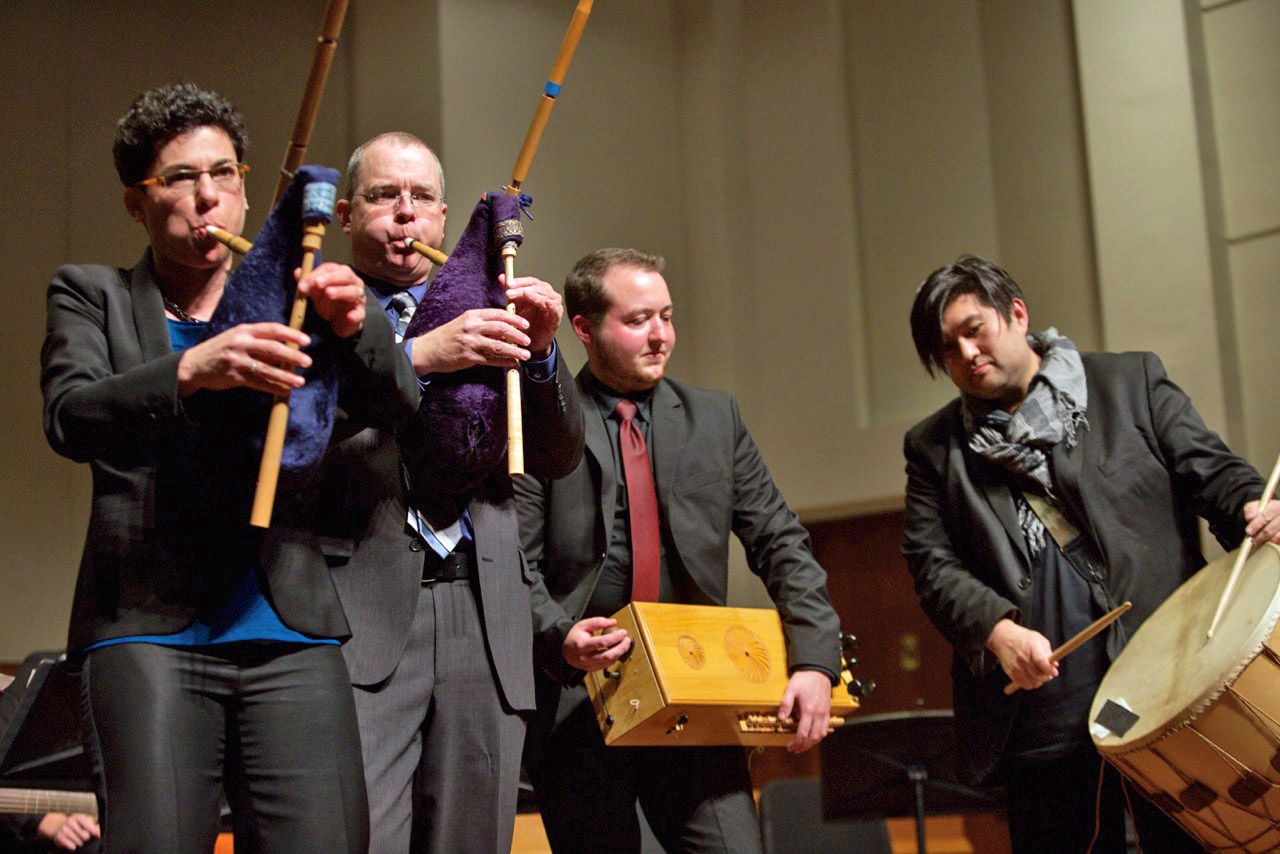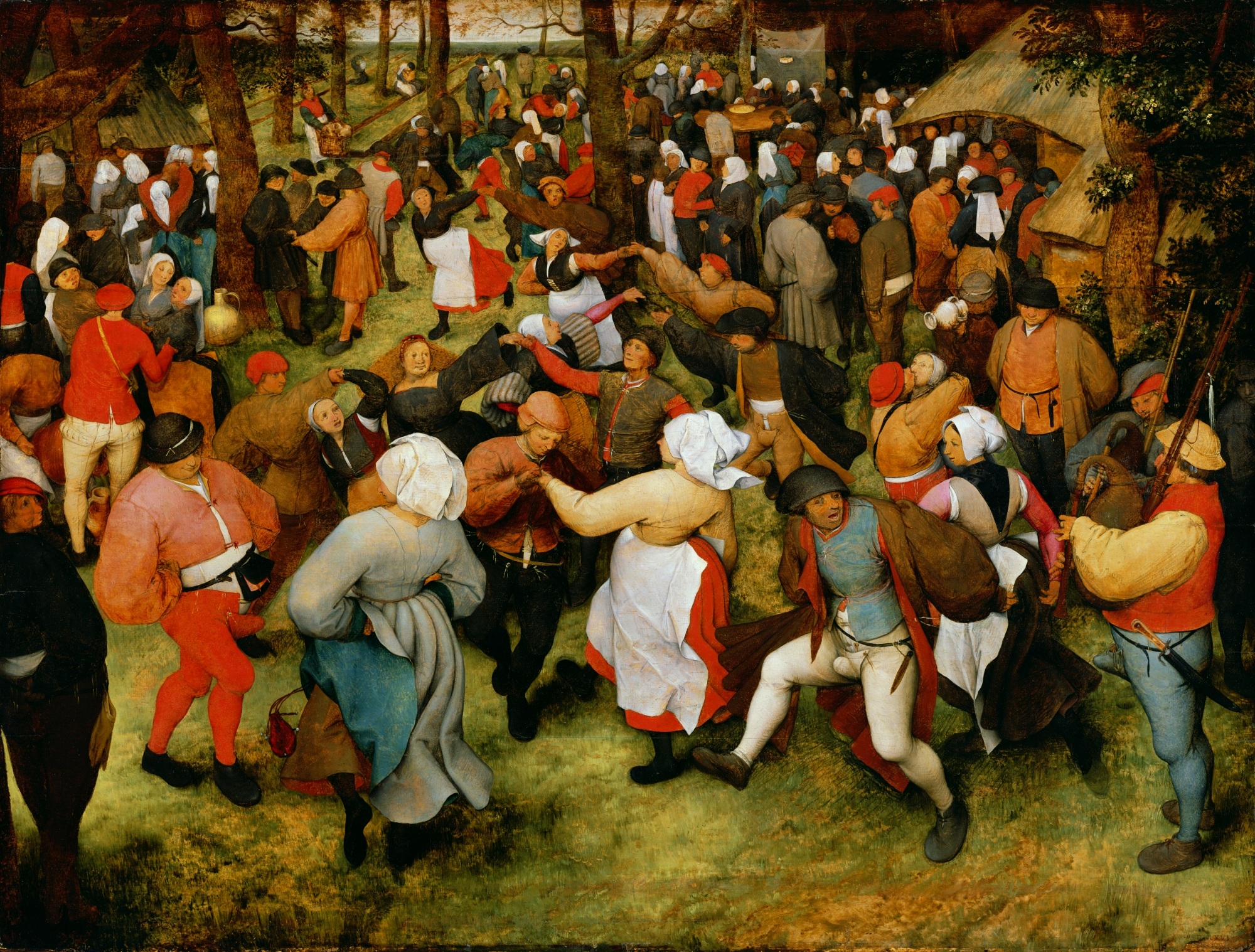The SFEMS concert series continues the weekend of November 17–19 with the return of everybody’s favorite shawm band, Ciaramella. Both the band and its co-directors, Adam and Rotem Gilbert, are well known to the Bay Area early music community and to SFEMS especially, through their performances both on our regular concert series and on the Berkeley Festival main stage, and through their work as directors or co-directors of two SFEMS summer workshops. Founded on a core of winds—shawm, sackbut, recorder, organ, and voice—Ciaramella takes its name from the Italian shawm and from a fifteenth-century song about a beautiful girl whose clothes are full of holes. When she opens her mouth, she knocks men flat. For their SFEMS concerts, the ensemble will consist of Adam Gilbert, shawm, recorder & bagpipe; Rotem Gilbert, shawm, recorder & bagpipe; Malachai Komanoff Bandy, shawm, viola da gamba, hurdy-gurdy & bagpipe; Adam Bregman, sackbut & recorder; Aki Nishiguchi, shawm & recorder; and Jason Yoshida, lute, guitar & percussion. Praised for performing intricate fifteenth-century counterpoint “with the ease of jazz musicians improvising on a theme,” Ciaramella brings to life medieval and early Renaissance music from historical events and manuscripts.
Their November concerts will take us back to a watershed year, 1517, which marked the beginning of the Protestant Reformation, the death of the great composer Henricus Isaac and the publication of Johannes Reuchlin’s The Art of the Kabbalah, a landmark book that changed the face of musical symbolism in the Renaissance. Ciaramella’s concert—performed on recorders, shawms, bagpipes, viola da gamba, lute, and guitar—features songs of love, lust, and devotion from the Lochamer Liederbuch, the Schedel Liederbuch, the Glogauer Liederbuch, the Songbook of Anna of Cologne, and the Kodex Leopold. The program includes works of Isaac, Paul Hofhaimer, and Ludwig Senfl, topped off with popular dances collected and arranged by Michael Praetorius.
Adam Knight Gilbert contributed the following notes on their program.
* * *
 The year 1517 ushered in the Protestant Reformation, marked the death of composer Henricus Isaac, and saw the publication of Johannes Reuchlin’s The Art of the Kabbalah, a work that profoundly influenced sacred and musical symbolism. Both before and after that watershed year, German lands resounded with song and dance. Amidst all the tumult, German musicians enjoyed reputations as some of the finest composers and performers of the era.
The year 1517 ushered in the Protestant Reformation, marked the death of composer Henricus Isaac, and saw the publication of Johannes Reuchlin’s The Art of the Kabbalah, a work that profoundly influenced sacred and musical symbolism. Both before and after that watershed year, German lands resounded with song and dance. Amidst all the tumult, German musicians enjoyed reputations as some of the finest composers and performers of the era.
The Lochamer Liederbuch contains a treasure trove of German melodies from the mid fifteenth century. This manuscript possibly reflects a Jewish musical culture, for it contains a Yiddish inscription in Hebrew letters, “For my most beloved Barbara.” The anonymous Mein traut geselle is one of few three-voice settings in Lochamer, which contains mainly monophonic melodies, like the popular song of disillusioned love, Zart lieb wie süß.
The second part of the Lochamer Liederbuch includes the 31 organ intabulations of Conrad Paumann’s Fundamentum organisandi. Born blind, Paumann was one of the most respected organists of his day, and his settings of German lieder like Mit ganczem willen provide insight into the rich tradition of contrapuntal improvisation in fifteenth-century Germany. Paumann also composed florid versions of French chansons, albeit with corrupt titles. For example, the oddly named Annavasana actually sets the French chanson “En avois”.
The anonymous Zart lieb wie süß enjoyed special popularity, surviving in a three-voice setting in the Schedel Liederbuch and in the melody of a sacred Polish hymn. As a student and doctor, Hartmann Schedel copied many songs into this manuscript, with scribal errors that reveal gaps in his musical training. Schedel’s collection shares a number of songs in common with the Glogauer Liederbuch. The anonymous In feuers hitz so brennet mein Herz survives in the Glogauer Liederbuch with the sacred contrafactum Mole gravati criminum. Ach rein zart shares enough traits in common with In feuers hitz to suggest shared authorship.
The Glogauer Liederbuch was collected by Martin von Rinkenberg, the Abbot of Żagań in Silesia. Evidence suggests that Rinkenberg copied the manuscript himself, until he was disabled by a stroke in 1482, close to the date of the last watermark in the manuscript. Heinrich Finck’s Nigra sum sed formosa, a four-voice setting from the biblical Song of Songs, is one of the final compositions copied into the book. Finck follows common German practice of setting the chant to notes of equal value, with outer voices paraphrasing the chant in florid imitation.
Three monumental manuscripts—Munich 3154 (“Kodex Leopold”), Leipzig 1494 (“Apel Kodex”), and Berlin 40021—preserve a wealth of German music from around 1500, including works by Henricus Isaac, Heinrich Finck, and the lesser known Conrad Rupsch der Singer, whose Nun bitt wir den haÿligen gaÿst and Maria salve virginum suggest that he could easily have studied with either Isaac of Finck. Adjacent to Maria salve virginum, unattributed Hymnizemus regi altissimo is so close to in style that we think it is also likely by Rupsch. In Gottes Namen fahern wir, one of the favorite chorale tunes both before and after the Reformation, was set by Finck, Isaac, and Paul Hofhaimer, Isaac’s colleague and friend and organist to Hapsburg Emperor Maximilian I.
Almost all of the songs in our program are Tenorlieder, in which outer voices dress the main melody held in the Tenor voice. Isaac’s Ach, was will doch bears striking resemblance to an anonymous version that sounds suspiciously like the handiwork of Ludwig Senfl, Isaac’s most famous pupil. Senfl’s Was wird es doch sets a beautiful soaring melody to a dark text, perhaps appropriate in a song about hypocrisy, in which sweet smiles hide evil glances. His Es taget vor dem Walde begins with the sound of a trumpet, announcing that the lovers must part before daylight reveals their tryst: “The day is breaking in the woods, the hares will be jumping shortly, wake up Käterlein, you are mine.” Parallels to this aubade or morning song range from Shakespeare’s Romeo and Juliet and the Everly Brothers hit, Wake Up, Little Susie. Our variations over Wil niemand singen are inspired by Senfl, for this charming little folk song survives only because he set it to polyphony.
 Dance played an especially important role in Renaissance society. The basse danse earned its name from its low gliding step that cultivated a sense of effortless ease. The manuscript of Marguerite of Austria preserves many of these dance melodies on black parchment with gold staves and silver notes. Despite its popularity, the only surviving polyphonic setting of Le petit rouen survives is found in a German manuscript from the sixteenth century. Our version adds polyphonic voices in a range of fifteenth-century styles—fauxbourdon, florid parallel tenths, ostinato patterns, and as a simple chordal dance—a short history of fifteenth-century counterpoint in one song.
Dance played an especially important role in Renaissance society. The basse danse earned its name from its low gliding step that cultivated a sense of effortless ease. The manuscript of Marguerite of Austria preserves many of these dance melodies on black parchment with gold staves and silver notes. Despite its popularity, the only surviving polyphonic setting of Le petit rouen survives is found in a German manuscript from the sixteenth century. Our version adds polyphonic voices in a range of fifteenth-century styles—fauxbourdon, florid parallel tenths, ostinato patterns, and as a simple chordal dance—a short history of fifteenth-century counterpoint in one song.
Born in Cologne, Tielman Susato earned his reputation in Antwerp as a successful instrumentalist, music publisher, and composer. His arrangements of popular dances in his Danserye remain some of the greatest hits of Renaissance music. Their unusual compositional style probably originated in Susato’s desire to make the music fit on a variety of wind consorts. We have been unable to resist playing these dances on bagpipes. Our pipes are based on paintings by Pieter Breughel and Albrecht Dürer. Our small bagpipes are based on engravings from Michael Praetorius’ Syntagma musicum, an illustrated dictionary of musical instruments. Their cylindrical bores create a sweeter buzzing sound, earning them the moniker “hummelchen” (“little bumble bee”).
Praetorius left a large body of sacred compositions for magnificent court choirs in Wolfenbüttel and Dresden. Yet he is remembered most for Terpsichore, his toe-tapping compendium of Renaissance dances that open and close our program. His Pavane d’Espaigne inspires our set of variations over this Spanish ground. We also add variations to Mein junges Leben hat ein Ende, one of the great moral songs of the Dutch Reform tradition. Outlining major and minor scales, its melody echoes a text that bids farewell to both joys and sorrows.
* * *
SFEMS presents Ciaramella at 8:00 p.m., Friday, November 17, at First Presbyterian Church,1140 Cowper Street (at Lincoln) in Palo Alto; 7:30 p.m., Saturday, November 18, at St. John’s Presbyterian Church, 2727 College Ave (at Garber) in Berkeley; and 4:00 p.m., Sunday, November 19, at St. Mark’s Lutheran Church, 1111 O’Farrell (at Gough) in San Francisco. Tickets are available online or through the SFEMS Box Office at 510-528-1725. If you haven’t yet subscribed you can still create your own mini-series, and save!












